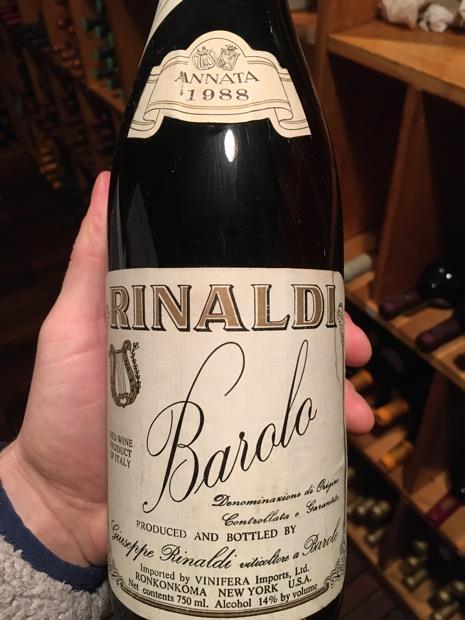
External search
Google (images)
Wine Advocate
Wine Spectator
Burghound
Wine-Searcher
Vintages
2011
2010
2007
2004
2003
2001
2000
1999
1996
1995
1993
1990
1989
1988
1987
1986
1985
1984
1983
1982
Show more
From this producer
Show all wines
All tasting notes
|
| Drinking Windows and Values |
| Community Tasting History |
| Community Tasting Notes (average 92.5 pts. and median of 92 pts. in 4 notes) - hiding notes with no text | | | Tasted by cardsandwine on 2/5/2016: 2016 La Festa Del Barolo. Got a small taste of this. Terrific wine. It soared from the glass with brilliance, focus and finesse. (2221 views) | | | Tasted by kenv on 3/28/2011 & rated 93 points: Left behind on our table at La Festa del Barolo, this is showing quite well after 48 hours of air. Still nearly opaque with just a hint of onion skin on the edge. Big smokey nose of sweet black fruits with hints of beef and roses. Thick in the mouth with firm tannic structure, I would say this still has 5-8 years before it reaches it peak. Very good length. Impressive! (3422 views) | | | Tasted by kenv on 3/26/2011 & rated 92 points: Gala Dinner of La Festa del Barolo (Del Posto Restaurant, NYC): A very good wine, but pales a bit after all these great wines. (4124 views) |
| Giuseppe Rinaldi Fine Wine Geek Giuseppe Rinaldi page
GIUSEPPE RINALDI
A family-run production company, it exclusively produces grapes produced from its own vineyards. At the beginning of the 19th century, Battista Rinaldi was a cultivator of some vineyards of the Feudo of the Marquises Falletti di Barolo. Later he became a farmer owner and, initially, a seller of the grapes produced. Later, with his sons, he became a winemaker and bottler. The same company tradition, of character and craft dimensions, today continues with Giuseppe Rinaldi and the fifth and sixth generation daughters. The company produces Barolo for about 60% (Brunate vineyards, Le Coste, Cannubi-San Lorenzo, Ravera) and for the rest, Piedmontese wines such as Dolcetto d’Alba, Barbera d’Alba, Nebbiolo and Freisa delle Langhe, Ruchè.NebbioloNebbiolo is a red grape indigenous to the Piedmont region of Italy in the Northwest. The grape can also be found in other parts of the world, though they are not as respected.
Nebbiolo is often considered the "king of red wines," as it is the grape of the famed wines of Barolo DOCG, Barbaresco DOCG, and Roero DOCG. It is known for high tannins and acidity, but with a distinct finesse. When grown on clay, Nebbiolo can be very powerful, tannic, and require long aging periods to reach its full potential. When grown on sand, the grape exhibits a more approachable body with more elegant fruit and less tannins, but still has high aging potential.
"Nebbiolo" is named for the Italian word, "nebbia", which means "fog", in Italian and rightfully so since there is generally a lot of fog in the foothills of Piedmont during harvest.
Nebbiolo is a late-ripening variety that does best in a continental climate that boasts moderate summers and long autumns. In Piedmont, Nebbiolo is normally harvested in October.
More links:
Varietal character (Appellation America) | Nebbiolo on CellarTrackerItaly Italian Wines (ItalianMade.com, The Italian Trade Commission) | Italian Wine Guide on the WineDoctorPiedmont Vignaioli Piemontesi (Italian only)
On weinlagen-infoLanghe Consorzio di Tutela Barolo Barbaresco Alba Langhe e Roero | Union of Producers of Albese Wines (Albeisa)BaroloRegional History:
The wines of Piedmont are noted as far back as Pliny's Natural History. Due to geographic and political isolation, Piedmont was without a natural port for most of its history, which made exportation treacherous and expensive. This left the Piedmontese with little incentive to expand production. Sixteenth-century records show a mere 14% of the Bassa Langa under vine -- most of that low-lying and farmed polyculturally. In the nineteenth century the Marchesa Falletti, a frenchwoman by birth, brought eonologist Louis Oudart from Champagne to create the first dry wines in Piemonte. Along with work in experimental vineyards at Castello Grinzane conducted by Camilo Cavour -- later Conte di Cavour, leader of the Risorgimento and first Prime Minister of Italy -- this was the birth of modern wine in the Piedmont. At the heart of the region and her reputation are Alba and the Langhe Hills. This series of weathered outcroppings south of the Tanaro River is of maritime origin and composed mainly of limestone, sand and clay, known as terra bianca. In these soils -located mainly around the towns of Barolo and Barbaresco -- the ancient allobrogica, now Nebbiolo, achieves its renowned fineness and power.
map of Barolo DOCG
An interesting thread on Traditional vs. Modern Barolo producers:
https://www.wineberserkers.com/forum/viewtopic.php?f=1&t=106291 |
|




